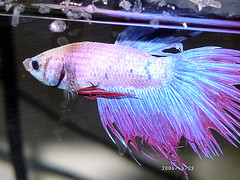Q: L wrote,
Is there a specific brand of flake or pellet food that is best for bettas? Should I go with something specifically made for them like Betta Bites or Omega One Betta Buffet?
A: There are a lot of great commercial fish foods out there that are appropriate for bettas but still some are better then others. There are a few things to consider when purchasing fish foods. I will go over briefly the pros and cons based on type.
Live, Frozen, Pellet or Flake
They all have pros and cons so it’s up to you to choose one or several types.
LIVE & FROZEN-
Pros:
Live and frozen foods are closest to a betta’s natural diet and may be more appealing to finicky fish. They are often considered superior by breeders and are used to condition bettas for breeding to ensure they are in the best possible shape. Because they are a natural choice they are less likely to cause digestive blockages. Frozen varieties will last a long time as long as they aren’t allowed to thaw.
Cons:
Live and frozen foods may cost more up front then dry flake, freeze dried or pellet food. There is a higher risk of parasitic or bacterial infections associated with live foods. Some people aren’t crazy about keeping live worm cultures in their home. Not every local fish store carried live or frozen foods. A variety of live or frozen foods are needed to maintain a balanced diet.
FREEZE DRIED & PELLETS-
Pros:
Freeze dried and Pellet foods can be quite affordable and are fortified with vitamins. While less appealing then live or frozen they tend to be more appealing to fish then flake foods. They are readily available at any local fish store. Reputable brands are guaranteed by the manufacturer to be parasite and bacteria free.
Cons:
Dry foods, especially pellets contain less then 10% moisture and often swell with water inside the Betta’s gut. They are the leading cause of constipation after overfeeding. Not all dry foods are created equal, most are loaded with fillers like wheat and soy meal which cannot be digested by carnivorous fish like Bettas. Check that fishmeal, crab meal or other animal meat is listed first on the ingredients label. They have a shorter shelf life then frozen foods and should be replaced every 30 days or so after opening which could make them more expensive in the long run.
FLAKE FOOD-
Pros:
Flake foods are affordable and are fortified with vitamins. They also have a very low moisture content but tend not to swell as readily as most pellet food. They are available at all local fish stores. Reputable brands are guaranteed by the manufacturer to be parasite and bacteria free.
Cons:
They are often the least appetizing to fish and not a good choice for picky eaters. Once opened, the vitamins dissipate quickly and should be replaced with a fresh batch about every 30 days. Because of their short shelf life they may be more expensive long term. Not all flake foods are created equal. Check that fishmeal, shrimp meal or other animal meat is listed first on the ingredients label.
With all that said it may take a bit of trial and error to figure out what works best for you and your bettas. I like to combine all types of fish food throughout the week but emphasizing live and frozen foods as the main dietary components. When selecting dry foods like pellets or flakes that have a low moisture content, it’s best to soak the food in a cup of tank water for 10 minutes before feeding to ensure they have swollen to their full size before your betta consumes them. Knowing their true size will help you to not overfeed as well.
I tend to purchase foods by brands I trust like Hikari or San Francisco Bay Brand. Hikari puts out several flavors of frozen fish food that are betta appropriate and come in different shapes and sizes. They also manufacturers Bio-Gold pellets which are very popular with Betta keepers and tend not to swell as much as some other brands.
When purchasing live food it’s important to keep them in an appropriate environment depending on the type and to never feed dead or dying foods to your betta. This will greatly reduce the risk of food born illnesses.
For more on betta feeding and types of food visit Feeding at Nippyfish.net.

Leave a Reply